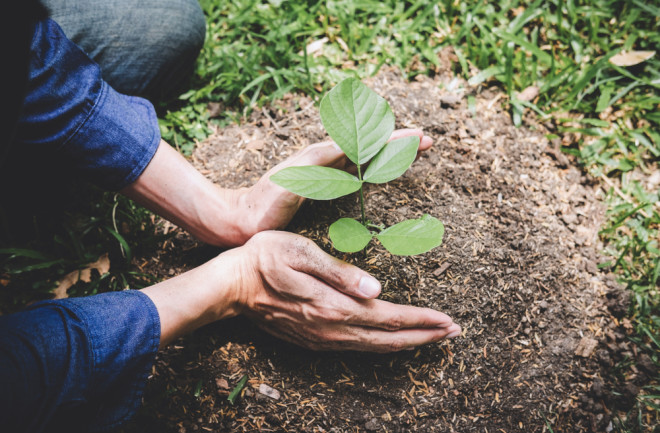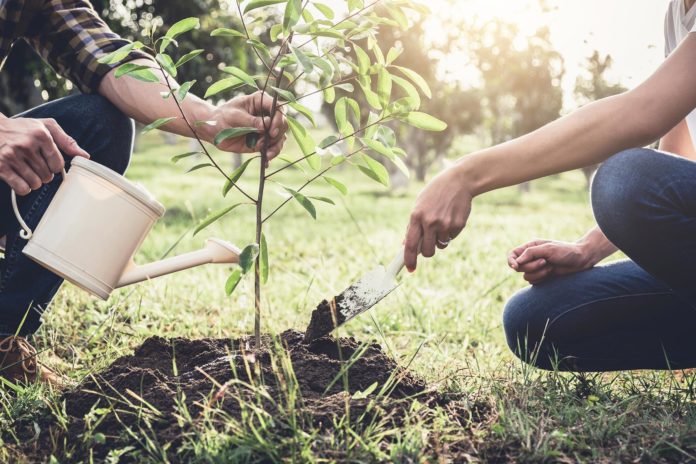The title of this article may seem very trivial to one as everyone knows how to plant trees. You dig a hole into the ground, put the saplings in, cover with some dirt, water and you’re done. You’ve planted a tree. But this couldn’t be farther from the reality. There is actually more to planting trees than just dig, dump and forget method. Special care must be taken to make sure the saplings are planted at the right location and are receiving ample resources to grow into a huge tree. Plant the wrong tree at the wrong place and it can die, have a stunted growth, destroy structures or worse, turn out to be invasive. Hence it is quite important you take a step by step glance through every little facet of planting a tree.

Choose The Right Location To Plant Trees
Location is everything when it comes to planting trees. Be it an afforestation drive or personal trees, kindly go through the pointers below on how to choose the ideal location for your trees.
- Make sure the tree has ample space to grow horizontally and vertically. In case it doesn’t have that it can have a stunted growth and not reach its full potential.
- If planting more than one tree, make sure there is sufficient space between the saplings. You do not want the trees all cramped up and competing for resources.
- Do not plant your trees near buildings or pavements to avoid causing any physical damage due to growing roots or branches.
- Your chosen location must receive sufficient sunlight and should not be in a very shady spot. Some trees need full sunlight while others can grow in partial shade. Choose your saplings accordingly.
- Make sure your location is not prone to heavy winds. In case it does, stake your saplings for extra support.
- Make sure your chosen site is not in a low-lying area where water tends to accumulate easily. Accumulated water can lead to root rot and will eventually kill the young saplings.
- Monsoons and the winters are the best time to plant your saplings. Planting saplings in summer will require extra observation and care.
Also Read: How To Shift To A More Sustainable And Eco-Friendly Lifestyle
Choose The Right Tree
The right kind of tree in the right environment can work wonders. Sometimes tree and plant species which are not native to the region can cause problems. They become invasive, hog all the resources from the local trees, do not support the local flora and fauna and can be detrimental to the local ecosystem.
- Always choose trees which are native to your region. They are well adapted to the local environment and perform in tandem with all constituents of the local ecosystem.
- To find out what are the native trees of your region, you can just make a simple search on www.google.com
- You can also get in touch with your local horticulture department for information on the same.
- The saplings of your selected native trees can be procured from the local nursery, horticulture department, forest department or even online.
- You can also start your own saplings at home in grow bags. Use seeds of native trees to start saplings at home.
Choosing The Right Soil to Plant Trees
Sunlight, water and soil are the three most important resources for a sapling to grow into a beautiful tree. Even if there is ample sunlight and water, in the absence of good soil the plants will perish.
- The soil should be loose. It means that the soil must be light and airy for the plants to properly spread their roots. In case the soil is compact, it must be turned before putting the saplings in it.
- The soil should allow the water to easily seep into it. Too compact and the water will accumulate at the base of the plant. Too loose and the water will immediately drain off leaving no time for the roots to absorb them. To summarize, the soil should be like a sponge which should be able to hold water for a decent amount of time.
- The soil should be rich in organic matter like dead leaves, twigs, hummus etc. These are the resources which will provide the initial nutrition to the young saplings. Organic matter like dry leaves, compost, vermi-compost must be added if the soil lacks in these materials.
The Planting Process
Now that we have taken care of basic things one needs to keep in mind before planting a tree, lets get started on the actual planting. This is a step by step guide on how you should proceed with it.
- Start by digging a square hole into the soil. The width of the square must not be more than twice the size of the root ball.
- Fill up the hole with water to check the rate of drainage. If it drains too fast or too slow, choose a different location.
- Do not fertilize the hole before planting the saplings. Too much nitrogen can burn the tender saplings. They should only be fertilised after a year of growth.
- Pick up your saplings by the root ball and remove all the foreign materials like grow bags and wires. Never handle the saplings by the trunk.
- Gently lower the root ball into the hole. Do not position the roots too deep into the soil.
- Gently cover the hole with the soil which came out of digging the hole. Do not compact the soil.
- Water near the base of the saplings and let everything settle on its own.
- If required, stake the saplings with a wooden stick so that they remain upright.
- Last step would be to mulch around the base of the sapling without touching the actual trunk. Organic materials like dry leaves, hay, coco peat and wood chips make for a really good mulch.
The Care Of The Saplings
Successfully planting a tree is only the job half done. Throughout a certain period of time, special care must be taken to make sure the saplings actually grow into huge, strong trees. Listed below are few pointers on how to care for newly planted saplings.
- Water at least around 3-4 times a week for up to a year to make sure the young saplings survive.
- The saplings would require even more frequent watering during the dry season. During monsoons, they would hardly require any manual watering.
- Young saplings can invite all kinds of herbivores like cows, goats, sheep etc. Hence a barrier must be created around the saplings to make sure they survive their initial years. The barrier can be any thing from metal cages to wooden fences.
- Avoid pruning newly growing trees. Pruning of healthy branches can lead to stunted root growth. Only remove the fallen or dead branches from the tree.
Also Read: How To Construct A Self-Sustainable Home
Conclusion
With all these things in your mind, you are now ready to properly plant trees. If you follow these steps meticulously, you can make sure your efforts do not go in vain and you end up with healthy trees in future. Trees are an important instrument in our fight against climate change and global warming. By planting more and more trees we can offset years of abuse this planet had to bear due to human greed. Trees are important resources and we must cherish them.
